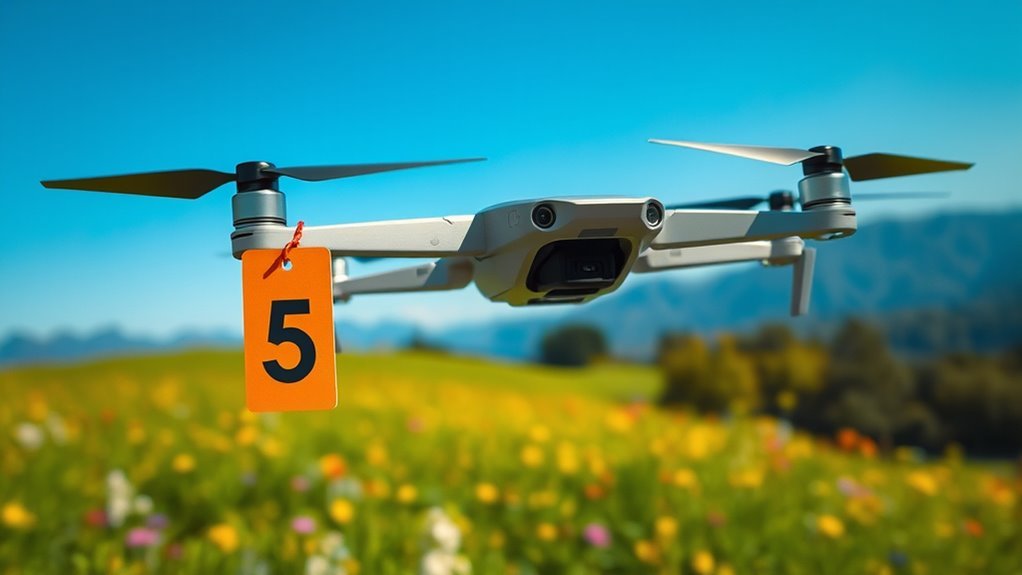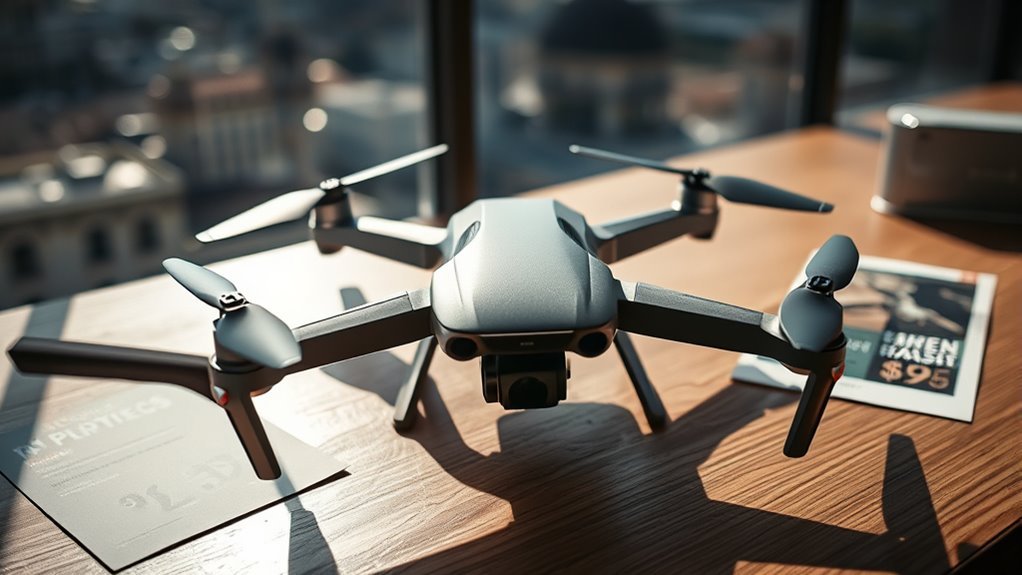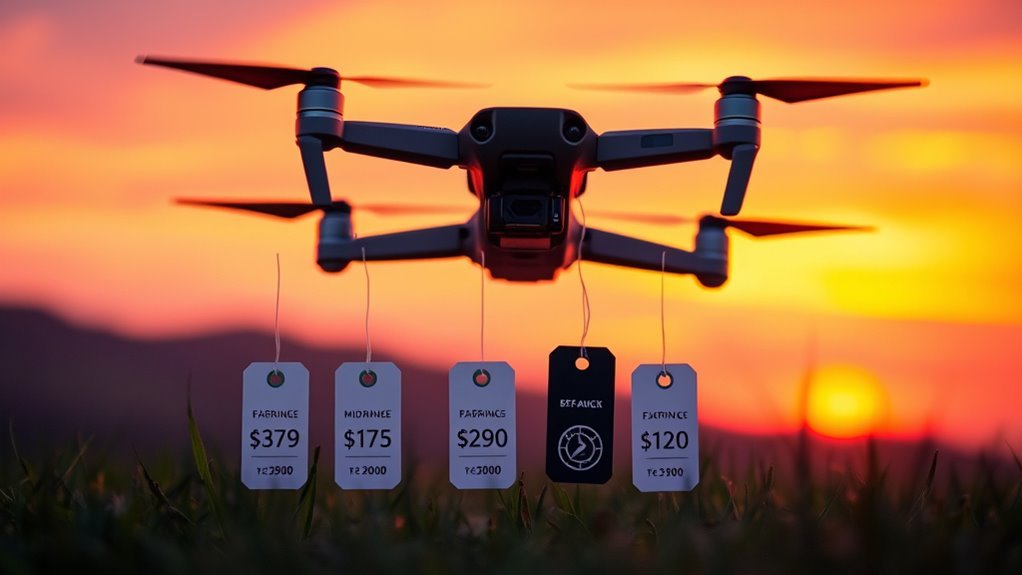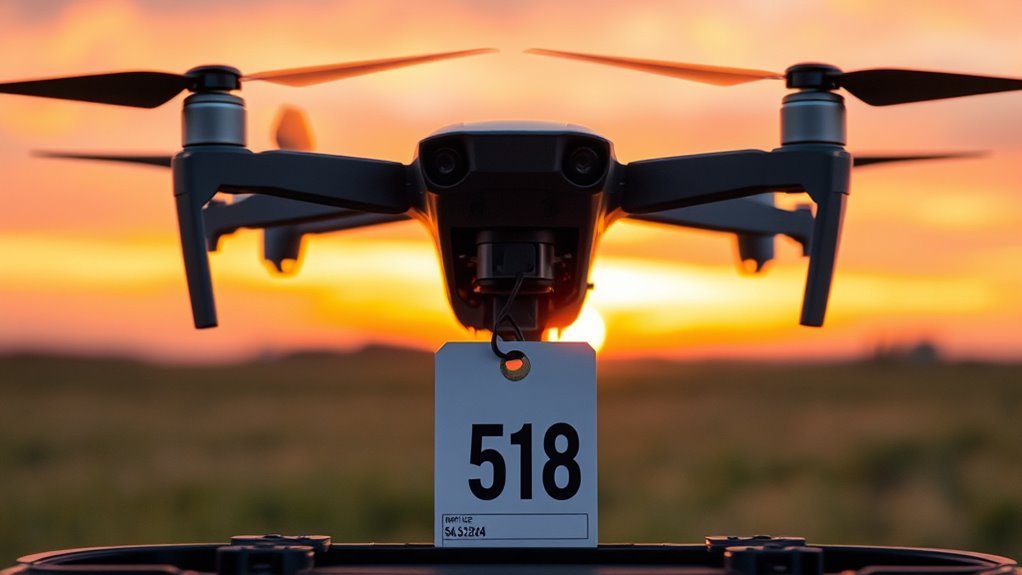Mobile drones typically cost between $100 for entry-level models to over $2,500 for professional-grade options. Prices vary based on features like camera quality, flight time, and brand reputation. Entry-level drones often suit beginners with basic functionalities, while mid-range options balance features and cost for hobbyists. Professional drones, equipped with advanced technology, cater to industries needing high-quality data. Understanding these aspects can help you make an informed decision; explore further to uncover more insights on drone buying.
Understanding Drone Types and Their Pricing

When considering the myriad of drone types available, how do you determine which one fits your needs and budget? First, it’s essential to understand that drone technology spans various categories, including quadcopters, fixed-wing drones, and racing drones, each designed for specific applications. Prices can vary dramatically based on features, capabilities, and brand reputation. High-end models with advanced sensors and longer flight times cater to professionals, while more basic models serve hobbyists. Additionally, market competition drives innovation and pricing strategies, making it important to compare options. Evaluating your primary use—be it aerial photography, surveying, or recreational flying—will help you choose a drone that aligns with your freedom-seeking spirit without breaking the bank. For instance, budget-friendly options like the Potensic Atom offer solid performance while catering to budget-conscious users looking for a reliable entry-level drone. Furthermore, drones with gimbal-based stabilization like the Hubsan Zino 2+ can provide enhanced image quality in dynamic environments.
Entry-Level Drones: Affordable Options for Beginners

Entry-level drones typically range from $100 to $500, making them accessible for beginners enthusiastic to explore the world of aerial technology. When you’re starting out, it’s essential to choose the best beginner drones that offer stability and ease of use. Affordable drone models often feature intuitive controls, decent battery life, and basic camera capabilities, allowing you to capture stunning aerial footage without breaking the bank. Look for drones with features like altitude hold and headless mode for a smoother flying experience. These entry-level options are designed to help you master the fundamentals of flying before advancing to more complex models. With the right choice, you’ll enjoy the freedom of flight while honing your skills in a safe and manageable way. Additionally, budget-friendly drones like the Potensic Atom provide core functionalities at a fraction of the cost, making them ideal for novice pilots. The Potensic Atom, for instance, offers advanced features that enhance the flying experience and ensure a smoother transition into more complex aerial maneuvers.
Mid-Range Drones: Balancing Features and Cost

While entry-level drones are great for beginners, mid-range drones offer a compelling balance of features and cost that caters to more serious hobbyists and aspiring aerial photographers. In this cost analysis, you’ll find that investing in mid-range options provides enhanced capabilities without breaking the bank. Here are three key advantages:
- Camera Quality: Mid-range drones often come with better cameras, allowing for high-resolution images and 4K video capabilities.
- Flight Time: You’ll typically experience longer flight times, ranging from 20 to 30 minutes, giving you more freedom to explore.
- Stabilization Technology: Advanced stabilization features guarantee smoother footage, making it ideal for capturing dynamic scenes.
Additionally, many mid-range drones are equipped with superior battery longevity to enhance your flying experience further. These mid-range features strike a balance that elevates your drone experience without overwhelming your budget.
Professional Drones: Advanced Technology and Higher Prices
As drone technology continues to evolve, professional drones have emerged as essential tools for industries like filmmaking, surveying, and agriculture, offering advanced features that come at a premium price. These drones are equipped with high-resolution cameras, advanced GPS systems, and sophisticated sensors, enabling precise data collection and stunning aerial imagery. When you invest in a professional drone, you’re not just purchasing a flying device; you’re acquiring a versatile platform tailored for specific professional applications. The higher price reflects the quality and durability of materials used, alongside the cutting-edge technology that enhances performance and reliability. Understanding these factors guarantees you make an informed decision, aligning your investment with your unique operational needs and aspirations for freedom in your professional endeavors. Additionally, professional drones like the Wingtra One Gen II excel in long-distance mapping capabilities, making them ideal for extensive surveying projects. The fixed-wing design of the Wingtra One allows for greater endurance and efficiency, further justifying its professional price point.
Factors Influencing Drone Prices
When considering drone prices, you’ll find that specifications and features play a critical role in determining value. Additionally, brand reputation can greatly influence your purchasing decision, as established brands often command higher prices due to perceived reliability. Finally, market demand and emerging trends can shift prices, making it essential to stay informed about current industry movements. For instance, drone technology trends highlight the importance of advancements in AI and operational efficiency, which can impact overall pricing. The rise of companies like Coretronic, which utilize AI-driven automation, is reshaping the competitive landscape and influencing pricing dynamics in the drone market.
Drone Specifications and Features
Understanding drone specifications and features is essential for grasping how these elements influence pricing. When evaluating the cost of a mobile drone, consider these vital factors:
- Drone Camera Quality: High-resolution cameras with advanced stabilization systems greatly increase a drone’s value.
- Battery Life: Longer battery life allows for extended flight time, which is essential for capturing more footage and enhancing usability.
- Build and Design: Materials used and the overall design can affect durability and performance, impacting the price point.
Brand Reputation and Trust
Brand reputation plays an essential role in determining drone prices, often influencing consumer trust and perceived value. When you consider a drone purchase, the brand’s history of reliability, innovation, and customer service can greatly impact your decision. High brand loyalty typically correlates with higher prices, as established brands invest in quality and support. This creates a cycle where consumer trust is reinforced; you’re likely to pay more for a trusted name. Conversely, lesser-known brands may offer lower prices but often lack the same level of assurance, potentially affecting your experience. Ultimately, the balance between brand reputation and cost is vital; understanding this relationship can empower you to make informed choices that align with your needs and preferences.
Market Demand and Trends
As the drone market evolves, shifts in consumer preferences and technological advancements greatly influence pricing. Conducting a thorough market analysis reveals key factors affecting costs:
- Consumer Demand: Increased interest in aerial photography, agriculture, and delivery services drives manufacturers to innovate, impacting price ranges.
- Technological Innovation: Advances in battery life, camera quality, and flight capabilities can lead to higher costs, as cutting-edge features become standard.
- Regulatory Changes: Government regulations often dictate the necessary technology and safety features, affecting production costs and, subsequently, retail prices.
Understanding these elements helps you navigate the market effectively. By staying informed about trends and shifts in consumer preferences, you can make better purchasing decisions and find a drone that aligns with your needs and budget.
The Cost of Accessories and Additional Equipment
While the initial price of a mobile drone may seem manageable, the costs associated with accessories and additional equipment can quickly add up. Understanding the various accessory types is essential for enhancing your drone’s capabilities. Important equipment like spare batteries, high-quality cameras, and carrying cases can greatly impact your budget. Here’s a breakdown of potential costs:
| Accessory Type | Estimated Cost |
|---|---|
| Spare Batteries | $50 – $150 |
| High-Quality Camera | $300 – $800 |
| Carrying Case | $30 – $100 |
| Extra Propellers | $15 – $50 |
These additional investments guarantee you maximize your drone’s potential and enjoy a more versatile flying experience, aligning with your desire for freedom in aerial exploration. Investing in advanced camera capabilities can significantly enhance the quality of your aerial footage, making the extra expenditure worthwhile. Additionally, understanding the battery life of your drone, such as the 40 minutes of flight time for the Lucid Sanitization Drone, can help you plan your flights more effectively.
Maintenance and Operating Costs of Drones
Although many enthusiasts focus on the initial purchase price of a mobile drone, it’s essential to take into account the ongoing maintenance and operating costs that can greatly influence your overall budget. Understanding these drone maintenance needs will help you prepare for future expenses:
- Battery Replacement: Over time, batteries degrade, leading to the need for replacements, which can be costly.
- Repairs and Parts: Accidents happen; whether it’s a propeller or camera, replacing parts can add up quickly.
- Software Updates: Keeping your drone’s firmware up-to-date may require subscription fees or one-time purchases. Additionally, the flight time of your drone can impact how frequently you need to charge and potentially replace batteries.
Budgeting for Insurance and Registration
When budgeting for a mobile drone, factoring in insurance and registration fees is essential to guarantee compliance and protect your investment. Insurance coverage varies based on the drone’s value, intended use, and specific risks involved. It’s important to evaluate different policies to find one that offers adequate protection against damages or liabilities. Registration fees depend on the drone’s weight and the regulations in your area, typically requiring you to register with national aviation authorities. Registration is required for drones over 0.55 pounds to ensure legal compliance. Be sure to account for these costs in your overall budget, as they’re not just additional expenses but critical components that ensure your drone operates legally and safely. Understanding these financial commitments can help you enjoy the freedom of flying your drone without unexpected legal hurdles. The potential US ban on DJI highlights the importance of considering supply chain disruptions in your budgeting strategy, as this could affect the availability of parts and support for your chosen drone.
Comparing Brands and Their Pricing Strategies
When evaluating mobile drones, it’s essential to understand how different brands approach pricing. Brand A offers a competitive pricing structure, while Brand B provides distinct features that may justify a higher cost. Meanwhile, Brand C emphasizes its value proposition, which can influence your purchasing decision based on your specific needs. Additionally, competitive pricing strategies from brands like Autel can enhance overall return on investment for budget-conscious consumers. This is particularly relevant as DJI drones typically hold value better due to their robust ecosystem of accessories.
Brand A Pricing Structure
Brand A’s pricing structure is a critical aspect to assess when comparing mobile drone options in today’s competitive market. Understanding their pricing strategies can help you determine the value you’re getting and how it aligns with your needs. Here are three key factors to take into account:
- Tiered Pricing: Brand A often employs a tiered pricing model, allowing you to choose a drone based on features and capabilities that meet your budget.
- Subscription Services: They may offer subscription services for software updates and maintenance, enhancing brand loyalty by providing ongoing support.
- Bundled Packages: Look for bundled packages that include accessories or extended warranties, providing more value without greatly increasing cost.
Brand B Features Comparison
While Brand A’s pricing structure provides valuable insights into its market position, examining Brand B’s features reveals how it competes in the same space. Brand B offers a unique combination of advanced specifications at competitive prices. For instance, their drones come equipped with high-resolution cameras and extended flight times that cater to both hobbyists and professionals. When you look at Brand B pricing, you’ll notice it undercuts competitors while maintaining quality, appealing to budget-conscious consumers. Additionally, Brand B specifications include features like GPS stabilization and real-time video streaming, enhancing user experience. By strategically positioning itself with these features, Brand B not only attracts a diverse audience but also emphasizes value for money without compromising on performance.
Brand C Value Proposition
Value is a critical factor in determining consumer choice among drone brands, and Brand C effectively leverages this concept through its unique pricing strategy. By offering competitive prices without compromising on quality, Brand C establishes a strong value proposition that appeals to both casual users and professionals. Here are three key aspects of Brand C’s approach:
- Innovative Features: Brand C integrates advanced technology, such as enhanced battery life and superior camera capabilities.
- Brand Reputation: With a solid track record for reliability, Brand C’s reputation assures buyers of their investment.
- Flexible Pricing: By providing various models at different price points, Brand C accommodates diverse consumer needs and budgets.
This strategic alignment enhances Brand C’s standing in the market, ultimately attracting a broader audience.
Tips for Finding the Best Deals on Drones
When you’re in the market for a drone, knowing where to look can greatly impact your budget. To find the best deals, consider exploring various online marketplaces, as they often host exclusive drone discounts. Here’s a quick reference to help you navigate your options:
| Marketplace | Average Price Range | Discounts Available |
|---|---|---|
| Amazon | $200 – $1,500 | Up to 20% |
| eBay | $100 – $2,000 | Up to 30% |
| Best Buy | $300 – $1,200 | Seasonal Sales |
| Walmart | $150 – $1,000 | Clearance Discounts |
| DJI Store | $500 – $2,500 | Trade-in Offers |
Frequently Asked Questions
What Is the Lifespan of a Typical Mobile Drone?
Imagine a race car; without proper maintenance, it won’t last long. Similarly, a typical mobile drone has a lifespan of 3-5 years, heavily influenced by battery lifespan and regular drone maintenance practices you adopt.
Are There Financing Options Available for Purchasing Drones?
Yes, there’re financing plans available for purchasing drones. Many companies offer leasing options, allowing you to manage costs effectively. This flexibility can empower you to choose the right drone without straining your budget.
Do Mobile Drones Require Special Licenses to Operate?
You’ll need to take into account drone regulations and licensing requirements when operating mobile drones. Depending on your location and usage, specific licenses may be required to guarantee safety and compliance with aviation standards.
How Often Should I Upgrade My Drone for Optimal Performance?
To maximize your drone’s performance, consider upgrading every 1-2 years. Keeping up with advancements in drone technology guarantees you benefit from performance enhancements, maintaining efficiency and reliability in your aerial operations.
Can Drones Be Used for Commercial Purposes Without Certification?
Did you know that over 70% of drone operators adhere to regulations? Without certification, using drones for commercial applications can lead to legal complications. Understanding drone regulations is essential for achieving your operational freedom while staying compliant.

